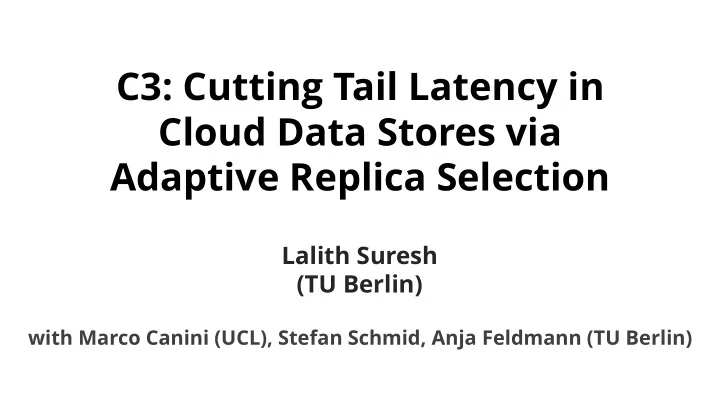

C3: Cutting Tail Latency in Cloud Data Stores via Adaptive Replica Selection Lalith Suresh (TU Berlin) with Marco Canini (UCL), Stefan Schmid, Anja Feldmann (TU Berlin)
Tail-latency matters Tens to Thousands One of data accesses User Request 2
Tail-latency matters Tens to Thousands One of data accesses User Request th percentile latency For 100 100 leaf servers, 99 99 th will reflect in 63% 63% of user requests! 3
Server performance fluctuations are the norm CDF Resource Queueing Background Skewed access contention delays activities patterns 4
Effectiveness of replica selection in reducing tail latency? ? Server Request Client Server Server 5
Replica Selection Challenges 6
Replica Selection Challenges • Service-time variations 4 ms Server Request 5 ms Server Client 30 ms Server 7
Replica Selection Challenges • Herd behavior and load oscillations Request Server Client Request Server Client Request Server Client 8
Impact of Replica Selection in Practice? Dy Dynami mic Sn Snitching Uses history of read latencies and I/O load for replica selection 9
Experimental Setup • Cassandra cluster on Amazon EC2 • 15 nodes, m1.xlarge instances • Read-heavy workload with YCSB (120 threads) • 500M 1KB records (larger than memory) • Zipfian key access pattern 10
Cassandra Load Profile 11
Cassandra Load Profile Also observed that 99.9 th percentile latency ~ 10x median latency 12
Load Conditioning in our Approach 13
C3 Adaptive replica selection mechanism that is robust to service time heterogeinity 14
C3 • Replica Ranking • Distributed Rate Control 15
C3 • Replica Ranking • Distributed Rate Control 16
µ -1 = 2 ms Client Server Client Server Client µ -1 = 6 ms 17
µ -1 = 2 ms Client Server Client Server Client µ -1 = 6 ms Balance product of queue-size and service time · µ -1 } { q q · 18
Server-side Feedback Servers piggyback {q s } } and { µν 𝒕 #𝟐 } } in every response Server Client #𝟐 } { q s , , µν 𝒕 19
Server-side Feedback Servers piggyback {q s } } and { µν 𝒕 #𝟐 } } in every response • Concurrency compensation 20
Server-side Feedback Servers piggyback {q s } } and { µν 𝒕 #𝟐 } } in every response • Concurrency compensation 𝑟 & ' = 1 + ¡𝑝𝑡 ' . 𝑥 + 𝑟 ' Outstanding requests Feedback 21
Select server #𝟐 ? with min ¡𝑟 & ' ¡. µν 𝒕 22
Select server Potentially long queue sizes • #𝟐 ? with min ¡𝑟 What if a GC pause happens? & ' ¡. µν 𝒕 • µ -1 = 4 ms 100 requests! Server 20 requests Server µ -1 = 20 ms 23
Penalizing Long Queues b Select server with min ¡ 𝑟 #𝟐 & ' ¡. µν 𝒕 µ -1 = 4 ms 35 requests Server b = 3 20 requests Server µ -1 = 20 ms 24
C3 • Replica Ranking • Distributed Rate Control 25
Need for rate control Replica ranking insufficient • Avoid saturating individual servers? • Non-internal sources of performance fluctuations? 26
Cubic c Rate Control • Clients adjust sending rates according to cubic function • If receive rate isn’t increasing further, multiplicatively decrease 27
Putting everything together C3 Client Replica group 1000 ¡ Server scheduler req/s 2000 ¡ Server Sort replicas req/s by score Rate Limiters { Feedback } 28
Implementation in Cassandra Details in the paper! 29
Evaluation Amazon EC2 Controlled Testbed Simulations 30
Evaluation Amazon EC2 15 node Cassandra cluster • M1.xlarge • Workloads generated using YCSB (120 threads) • Read-heavy, update-heavy, read-only • 500M 1KB records dataset (larger than memory) • Compare against Cassandra’s Dynamic Snitching (DS) • 31
Lower is better 32
2x – 3x improved 99.9 percentile latencies Also improves median and mean latencies 33
2x – 3x improved 99.9 percentile latencies 26% - 43% improved throughput 34
Takeaway: C3 does not tradeoff throughput for latency 35
How does C3 react to dynamic workload changes? • Begin with 80 read-heavy workload generators • 40 update-heavy generators join the system after 640s • Observe latency profile with and without C3 36
Latency profile degrades gracefully with C3 Takeaway: C3 reacts effectively to dynamic workloads 37
Summary of other results Higher system load > > 3x 3x better 99.9 th Skewed record sizes percentile latency SSDs instead of HDDs 50 50% higher throughput than with DS 38
Ongoing work • Tests at SoundCloud and Spotify • Stability analysis of C3 • Alternative rate adaptation algorithms • Token aware Cassandra clients 39
? Server Client Server Server Summary C3 Replica Ranking + Dist. Rate Control 40
Recommend
More recommend